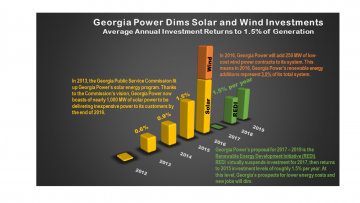Georgia Power’s IRP misses the mark on renewables
Company’s three-year plan still reliant on dirty, outdated coal
Contacts:
Melissa Williams, Sierra Club, (828) 545-0443, [email protected]
Jennifer Rennicks, SACE, (865) 235-1448, [email protected]
ATLANTA, GA — Today, Georgia Power Company, the state’s largest utility and an arm of Southern Company, filed a new Integrated Resource Plan (IRP) with the Georgia Public Service Commission that will dim the lights on Georgia’s transition to clean energy. The IRP will guide Georgia Power in identifying resources to meet the energy needs of its customers over the next several years.

Although Georgia Power has touted the benefits that renewables offer to its customers, the company is proposing to throttle back on the growth of its successful renewable energy program that propelled Georgia forward as a solar leader. Instead, the company will continue prioritizing old, dirty and expensive coal-fired power plants to meet any future demand for electricity and flat-line energy efficiency programs that help families save money.
“There is abundant, clean and cheap wind and solar power readily available to serve Georgia Power customers,” said Anne Blair, clean fuels director for the Southern Alliance for Clean Energy. “Georgia already has 20,000 jobs in the clean energy sector, and the Public Service Commission can continue to support this growth industry by scaling up this successful program.”
Georgia Power’s filing also fails to propose the retirement or phase-out of its oldest and most expensive coal-fired coal plants to operate, like Plants Hammond or McIntosh. For example, a report issued last year by the Institute for Energy Economics and Financial Analysis found that Plant Hammond costs $94 per megawatt hour to operate — twice as much as it costs Georgia Power to buy power on the market, especially low-cost wind power from the Great Plains. Moreover, Plant Hammond operated only about 15 percent of the time in 2014, likely due to increases in costs to run the plant. Keeping these plants in operation is an uneconomical choice for Georgia Power customers.
“I hope the commissioners act to protect our health and our pocketbooks by putting these dirty, outdated coal plants, like Plant Hammond, on a schedule for retirement,” said Colleen Kiernan, director of Sierra Club’s Georgia Chapter. “We look forward to productively engaging the commission on the right choices for our energy future, because increasingly cheap wind power, solar energy, and energy efficiency investments beat the dirty fuels of the past every time.”
###
About the Sierra Club
The Sierra Club is America’s largest and most influential grassroots environmental organization, with more than 2.4 million members and supporters nationwide. In addition to creating opportunities for people of all ages, levels and locations to have meaningful outdoor experiences, the Sierra Club works to safeguard the health of our communities, protect wildlife, and preserve our remaining wild places through grassroots activism, public education, lobbying, and litigation. For more information, visit http://www.sierraclub.org.
About the Southern Alliance for Clean Energy
Founded in 1985, the Southern Alliance for Clean Energy promotes responsible energy choices that work to address the impacts of global climate change and ensure clean, safe, and healthy communities throughout the Southeast. Learn more at www.cleanenergy.org.